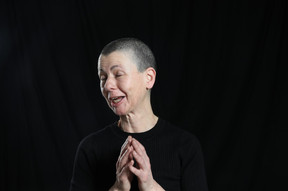Higher Self
The shooting was organised by the artist in such a way as to be able to proceed to the experience of individual sessions of self-portraits according to precise instructions. This part, which was very intense for the artist, was rigorously structured because she demanded a substantial inter-relational engagement from participants. Having established a list of essential points to observe when in front of the camera (the position of the camera, the lighting and the black backdrop decided by the artist never change), Cristina Nuñez invited each person to express a powerful feeling such as sadness, joy, fear, anger, etc. A dozen images (directed self-portraits but without the artist's presence) were produced by each one according to the chosen expressions. At the end of this shoot, the artist discussed the results by reducing the choice to more or less three photos per person. In the following stage, the most educational one, every participant presented and discussed their choice in front of the group in the artist's presence. The active participation was developed and led by the artist, who proved to be a fine teacher. She aimed to analyse the photographs using three important selection criteria. The students projected and analysed every photograph according to the degree of the image's multiplicity, temporality and harmony. These notions indicate that standards based on beauty or photogenia are not favoured by Nuñez's method. The Higher Self series, through its play on watched-watcher, subject-object, interior-exterior, and production-reception, became a quest for the self and the other, intending to question art while playing the art game. This creative process develops from this conjunction of individual experience at the time of the shooting and the group experience during the analysis of the productions. But this intention flows directly from the artist who takes the person on board only if s/he accepts to free personal experience so that it can be transformed into an artistic experience. In a sense, this means that the image's co-author renounces becoming the photograph's co-author as artwork. This approach, the antithesis of the simple photographic portrait or self-portrait, is closer to conceptual art, relational aesthetics or even formal art. -- extract from the catalogue text by Paul di Felice















